|
Fans: Advertising & Souvenir
By Donald Bull
Posted September 2015

Remember when you could go to the corner store on a hot day and get a free fan to cool yourself? Or when you went to church and found one next to the Bible in the back of the pew in front of you? Now, we step out of our air-conditioned homes, into our air-conditioned automobiles, and go off to the air-conditioned shopping center. But there are still those days when you sit on the front porch and watch the traffic go by while waving a fan to keep cool. Or perhaps you are going to an outdoor sporting event (not the cooled bubble-dome stadium)—you’ll need a hand fan.
Although not as popular today, there was a time when merchants of all sorts had fan giveaway promotions to lure customers. There were even days at the baseball park dedicated to the fans by giving away fans on a hot day instead of bats or hats. Cruise ships handed them out to keep you cool on deck. You could buy a souvenir fan at the World’s Fair and at the bullfight. Everywhere you went in the summer heat, you could find a fan to keep cool—and those with advertising were usually free.
|
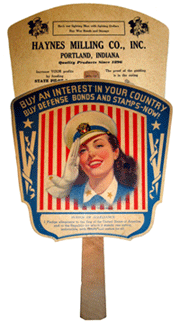
A patriotic stick fan from the Haynes Milling Company, Portland, Ind., suggesting “Buy an interest in your country – Buy defense bonds and stamps – Now!”
|
Gorgeous folding fans with printed scenes sandwiched on a number of sticks dominate the colorful European fans with some exceptional late 19th century–early 20th century examples from railroads, theaters, perfume companies, cruise ships, restaurants and beverage companies. Some of the most interesting are those from the Champagne houses that had wonderful designs created by popular artists of the time. The artists created advertising posters, and the same art was often used on the fans.
In contrast, the North American fans are mostly cardboard die-cut fans and stick fans. They were cheap and usually ordered in large quantities. An order could be delivered quickly. In a review of the National Printing, Publishing, Advertising and Allied Trades Exposition in New York’s Grand Central Palace, the May 22, 1900 edition of the New York Daily Tribune noted, “Souvenir fans printed on an automatic press at the rate of fourteen thousand an hour were distributed last evening.”
|
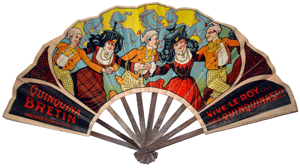
|
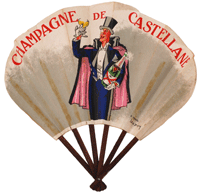
|
|
Farandole dance to celebrate Quinquina Bretin on a folding fan, made by Chambrelent.
|
C. 1935 folding fan design created for Champagne de Castellane by Léo Dupin (1898-1971).
|
The simplest fans to produce were stick fans where a printed piece of cardboard is stapled to a stick handle to grasp and wave. Unfortunately, many of these found staples on the noses of pretty girls or stuck in a nice outdoor scene. The advertising was usually printed on the reverse side of a stock design.
To lure you into the soda fountain, the owner would have promotion days to give away fans with an enticing picture of a root beer float or a bowl of ice cream and of course, advertising on the back. Samuel W. Dunaway, The Reliable Druggist in El Centro, Calif., boasted in his advertising that his soda water was “the best that money can buy.” In his advertisement in the May 2, 1908, edition of the Imperial Valley Press, his soda fountain was promoted as “Best Seats in Town, Seats for Everybody, Get A Free Fan, Come Once and You Will Come Again.”
|
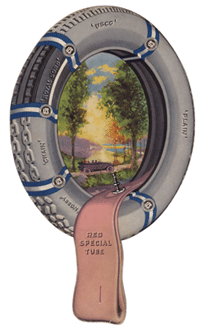
|
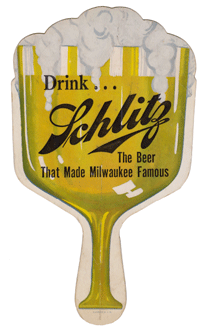
|
|
A die-cut fan from the United States Rubber Company with a car traveling through a scenic landscape inside the tire and showing the “Red Special Tube.” The reverse says, “United States Tires Are Good Tires.”
|
A die-cut fan stating, “Drink Schlitz The Beer That Made Milwaukee Famous.” It is marked with U.S. patent numbers 1,200,738 and 1,841,137.
|
Some merchants offered prizes via their fans. The fans were numbered, given away on a special promotion day, and a few days later, the winning number would be posted in the store window.
If you went to the theater packed with hundreds of people, the body heat demanded the use of hand fans. In 1913, The Moving Picture World magazine, reported that an advertising specialty firm was producing “Photoplayer Fans” featuring popular male and female stars on the front and advertising on the back. A theater could buy 500 of them for only $6.50.
|
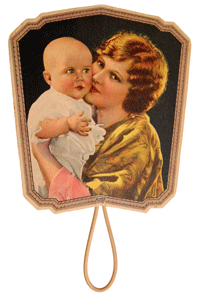
|
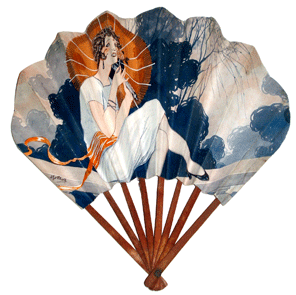
|
|
A sample loop handle fan from the U. O. Colson Company, Paris, Ill., marked “Pat. No. 1,994,105.” Founded by Usher Osborn Colson in 1892 to print identification tags for grain sacks, by the 1910s, it was producing many advertising specialty items including fans, menus and custom calendars.
|
A folding fan of a lady with a parasol and flower for Café de Paris Armenonville Pré Catelan Fouquet; signed “Gotthelf.”
|
The Moxie Company issued a fan annually for years featuring stars of the time on what is known as a thumb hold fan. Fans can also be found advertising Pepsi, Coca-Cola, 7-Up, Orange Crush and a great variety of beers. In Europe fans advertising apéritifs, cognac, liqueurs and other spirits were quite popular.
For the ladies steaming under the hot hair dryer at the beauty parlor, a fan was a necessity. And the gentleman operating his tractor on a hot summer day was helped out with fans from Caterpillar Tractor, Buckeye Mowers, and other farm equipment firms. Also, we must not forget the children who could get fans while trying on Buster Brown Shoes.
|
A loaf of Wards Tip-Top Bread bursts out of the star-covered front of this die-cut folding fan. Cooling snack suggestions are on the reverse.
|
So hotels, airlines, department stores, pharmacies, grocers, furniture stores, banks, insurance companies and so many other entities gave away fans to keep you cool. But there was another that not only kept you cool but hopefully, kept you from fainting while attending a service—at the funeral home. They usually promoted stock scenes on the back, often religious, floral or patriotic. Some noted they had “Lady attendants” while others offered ambulance services or “prepaid funeral contracts.” The reporter Elm wrote in his “After All” column in the December 12, 1954 edition of the Hutchinson News-Herald (Kansas): “Now another bit for this column of nostalgia concerns something I am not equipped to discuss. This is the cardboard fan which undertaking establishments used to distribute to churches for hot morning worshippers to use in attempting to cool off their immediate vicinity. The undertakers used to have fans for use in their own establishment, too, but most of them are air conditioned now—the establishments, that is. I just haven’t been to church recently and know nothing of ecclesiastical conditions. Maybe I should attend to learn the facts of life.”
|
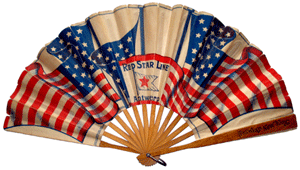
|
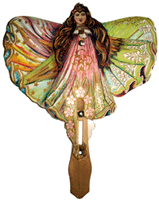
|
|
Red Star Line is nestled amongst American flags on one side of this folding fan and Dutch folks appear on the other. Made by Éventails Chambrelent, Paris.
|
Folding butterfly fan with paddle handle saying, “Souvenir du Concert de l'Union des Femmes de France” (souvenir of the concert of the Union of Women of France for the benefit of various charitable women organizations). Made by Leopold Verger et Cie.
|
In closing, here’s a great story about fans at a baseball game as reported in the New Castle News (Pennsylvania) on September 1, 1966:
“Fan Waving Gets D Hot – The fans at Forbes Field got Los Angeles Dodger hurler Don Drysdale a little hot under the collar Wednesday night. It was not so much the spectators in the stands but the 30,000 souvenir fans presented them as they entered the gates. For picture purposes, the public address announcer had asked the patrons to wave the fans at the count of three. But in the fourth inning, with Pirate slugger Willie Stargell batting, the fans took up their own count. At three, 30,000 arms went up as one. Drysdale complained to the umpires who halted play. The response from the stands was a shower of fans on the playing field. Time was called for 10 minutes while the ground crew cleared the field. When play resumed, Stargell singled Roberto Clemente to third, but Drysdale escaped the inning without surrendering a run.”
-----------------------------------
Fans: Advertising & Souvenir by Donald Bull & Rodolph Roger (Schiffer Publishing Ltd., 2012) has more than 1,750 color photos. The 288-page, oversize, hardcover book is a heavyweight at four and one-half pounds. The information and the fans with their value ranges will astound and excite all fan collectors. The book is divided into forty-three categories from Agriculture to Wine. The authors are from different sides of the Atlantic so they were able to amass a dazzling array of fans representing Europe and North America, plus a handful from other locations. Two indexes show the wide variety of fans by artists as well as manufacturers and suppliers.
|